Abstract
In order to improve the seismic performance of reinforced concrete (RC) frames, carbon fiber-reinforced polymer (CFRP) was used to retrofit reinforced concrete frame structures. The comparison pseudo-static test results show that the peak load, initial stiffness and ductility of the CFRP retrofitted model were increased by 43.89%, 39.27% and 30.1%, respectively. Based on the parametric study of the finite element model, the contribution of CFRP to the seismic upgrading effect of RC columns was quantitatively revealed, and an optimized design of retrofitted CFRP was proposed. The results show that the peak load, ductility and energy dissipation capacity of the whole structure are improved by using CFRP full-wrap reinforcement and strip reinforcement models with different coverage areas. The damage degree of the column decreases, the damage degree of the beam increases, and the failure mode changes from “column hinge” to “beam hinge”. Simultaneously, different CFRP reinforcement areas and the distance between strip CFRP have different reinforcement effects on concrete structures. Based on the investigation results, the recommended ratio of CFRP strip to spacing is 1 to 1.25.
1. Introduction
Based on the design concept of “strong columns and weak beams”, reinforced concrete frame structures are damaged by the overall yielding mechanism of the “beam hinge” during an earthquake, which can realize the ideal deformation capacity of the structure under the premise of beam hinge energy dissipation to give the structure a more ideal energy consumption performance. However, in the destructive earthquakes that have been seen since the turn of the new century, the actual earthquake damage of reinforced concrete frame structures shows that after setting up the infill wall, the reinforced concrete frame structure usually yields at the column end first [,,,,]. To address the real-world problem, the use of carbon fiber reinforcement is an effective way to improve the failure modes of frame beams and columns. Carbon fiber-reinforced polymer (CFRP) has been widely used for structural rehabilitation, repairing and strengthening owing to its superior properties, such as high tensile strength, light weight, excellent corrosion- and fatigue-resistance, convenient installation scope and durability [,,,]. Moreover, CFRP reinforcement can reduce the average stress in the original structure and significantly increase the fatigue life []. Currently, externally bonded CFRPs are well accepted owing to their simple workmanship requirements and convenient construction. However, with this technique, only 20–30% of the tensile strength of the CFRP can be utilized owing to the debonding failure between the CFRP and concrete. The prestressed CFRP has shown more efficient strengthening results, which would offer more advantages, such as reducing the deflection and crack widths of the strengthened concrete structures, delaying the onset of concrete cracking and the yielding of the internal steel reinforcements, and the removal of premature debonding failure. However, it is more complicated to determine the control value of prestress, the application system and the end anchorage [,].
The results of domestic and foreign experimental research show that the ductility, bearing capacity and seismic performance of columns after reinforcement with CFRP have been significantly improved [,,,]. In recent years, domestic and international research on the CFRP retrofitting of reinforced concrete structures has focused on the reinforcement of individual members. Dirikgil T. [] and Jizhong Wang et al. [] retrofitted reinforced concrete columns using CFRP and analyzed the force properties under cyclic lateral loading, finding that the ductility and load carrying capacity of the columns after retrofitted were significantly improved. Wei et al. [,] presented an effective partial confinement method, whereby different layers of CFRP sheets were wrapped around the lower-strength part to explore the improvement achieved by partial confinement; the experimental results indicate that both the strength and the ductility of the lower-strength part could be significantly increased. Ilki A. [] and Benzai et al. [] conducted axial compression tests on CFRP-retrofitted reinforced concrete columns, which showed that the strength and ductility of the columns after CFRP reinforcement were substantially improved. Haiyang Zhu [] and Tingyan Wang et al. [] used CFRP to retrofit concrete beams, and to investigate the effects of the anchoring method by assessing whether the concrete beams are damaged by the reinforcement. Lin Shu [] and Zheng Fang al. [] studied the effect of the amount of CFRP on the ultimate bearing capacity of reinforced concrete slabs. A novel wedge-shaped bond anchorage system was developed by Li et al. []. This wedge–extrusion bond anchor successfully anchored the CFRP plate. A higher anchorage bearing capacity and stress level were obtained, and the optimal tensile properties of the CFRP plate were achieved. Zhimei Zhang [] and Xinzheng Lu et al. [] investigated the mechanical properties of CFRP-retrofitted columns under axial compression by means of finite element numerical simulation. Some scholars have also conducted experimental studies on the overall framework model. Xiaoyun Guo [] and Jianming Guo et al. [] investigated the effects of CFRP retrofitting on the overall seismic performance of frames via proposed static tests. Eslami et al. [] used CFRP to reinforce a frame structure, and showed that CFRP-reinforced frame structures exhibit an optimized failure mode across the overall structure. Balsamo [] and Chen et al. [] used CFRP to strengthen the RC frame structure, and conducted seismic tests, which showed that CFRP reinforcement can improve the energy dissipation capacity, strength and ductility of the overall structure.
The above experiments and finite element simulation studies have verified that the bearing capacity and ductility of structural members after CFRP retrofitting are improved, which is of benefit to the seismic performance of the structure. However, the above studies are limited to the CFRP reinforcement of individual components, such as reinforced concrete beams, slabs, and columns, and there are fewer studies that consider the effects of CFRP reinforcement on the seismic performance of the overall structure, or that undertake parametric quantitative analysis. In this paper, the proposed static tests were conducted on a set of ordinary-model and CFRP-retrofitted columns, and finite element modeling calculations were carried out on the experimental models to reveal the effects of CFRP retrofitting on the failure modes of the frame columns; based on the parametric analyses, the effects of strip-retrofitting on frame columns has been quantitatively investigated, with CFRP utilization rate, width, and spacing as the controlled parameters. Further, CFRP full-wrap and strip-retrofitted frame columns have been quantitatively studied in comparison with those of CFRP full-wrap and strip-reinforced frame columns at the structural level. The effects of CFRP full-wrap and strip-retrofitting on the seismic performance of the structure are here investigated via a comparative study at the structural level.
2. Experimental Program
2.1. Experimental Design and Material Properties
In this experiment, two groups of reinforced concrete beam–column models were designed and fabricated to carry out the proposed static tests, and the experimental models were taken from a two-bay, one-span frame structure model on the first floor of the teaching building of the Xuankou Middle School, with a scaled-down ratio of 1:4, one group of which was the ordinary model, and the other group of which was the CFRP-retrofitted model, and the axial compression ratio was applied by the artificial mass in order to guarantee the constant axial compression ratio during the test. The experimental models are shown in Figure 1.
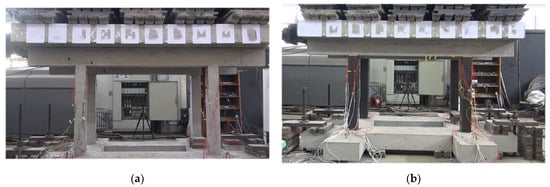
Figure 1.
Ordinary and retrofitted RC frame model of pseudo-static test: (a) ordinary model; (b) retrofitted model.
The cross-sectional dimensions of the beams are 120 mm × 200 mm with a length of 2300 mm, and the cross sectional dimensions of the columns are 120 mm × 120 mm with a height of 1000 mm. Both columns and beams are configured with 4 bars of HRB335 grade with a diameter of 10 mm as shown in Figure 2. The hoop reinforcement is made of HPB300-grade galvanized iron wire of 3 mm diameter, the spacing of the non-encrypted zone of column hoop reinforcement is 50 mm and the spacing of the encrypted zone is 25 mm, while the spacing of the beam hoop reinforcement is 100 mm without an encrypted zone. The thickness of the protective layer of concrete on the columns is 10 mm, and the thickness of the protective layer of concrete on the beams is 20 mm. The reinforcement bars used in the experiment all meet the requirements of the Code for Structural Design of Concrete Structures (GB 50010-2010) [].
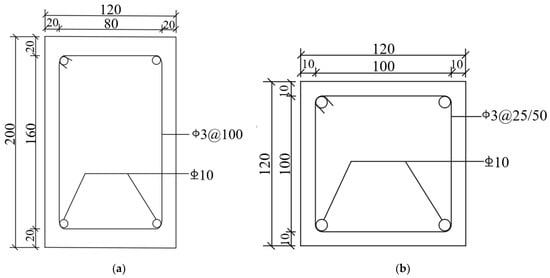
Figure 2.
Beam and column dimensions and reinforcement diagram: (a) beam section reinforcement diagram; (b) column section reinforcement diagram.
The strength class of the concrete of the model was C30, the mass ratio of cement, sand and stone was 1:1.65:3.36, the strength of the cement was 42.5 MPa, the water–cement ratio was about 0.6, and the model was cured for 28 days in an indoor environment after it had been made. After making the experimental model, three 150 × 150 × 150 mm cubic specimens and three 150 mm × 150 mm × 300 mm prism-shaped specimens were made. The axial compression test of the test block was carried out on the test day using the Changchun Kexin YAW-2000 (Changchun Kexin Testing Instrument Co., Ltd, Changchun, China) electro-hydraulic servo press (Figure 3).

Figure 3.
Axial compression test of concrete specimens: (a) cube specimen; (b) prism specimen.
The retrofitted model chamfered the four columns, polished the corners of the columns smoothly without leaving any edges, and then retrofitted the columns with CFRP (Figure 1b). The CFRP was produced by Changzhou Baifeng Carbon Fiber Company (Changzhou, China), and the bonding adhesive was made by mixing epoxy resin adhesive with curing agent according to the quality ratio of 4:1. We brushed a layer of adhesive on the surface of the column, wrapped a layer of CFRP around the full height of the column, and set the fiber weaving direction along the circumferential direction of the column. We then brushed a second layer of adhesive onto the CFRP, with a lap length of 100 mm. A number of 200 mm × 30 mm CFRP specimens were made, and tensile tests were carried out with an MTS Model E45 (MTS (China) Co., Ltd., Shenzhen, China) universal testing machine according to the “Test Method for Tensile Properties of oriented fiber reinforced Plastics (GB/T 3354-1999)” [], as shown in Figure 4. The tensile strength and elastic modulus of the CFRP can be calculated according to and , respectively. is the tensile strength, is the peak tensile failure load, b is the width of the specimen, t is the thickness of the specimen, E is the elastic modulus, l is the original length of the specimen, is the load increment in the elastic stage, and is the elongation-at-break of the specimen. The performance parameters of the materials are shown in Table 1 and Table 2.
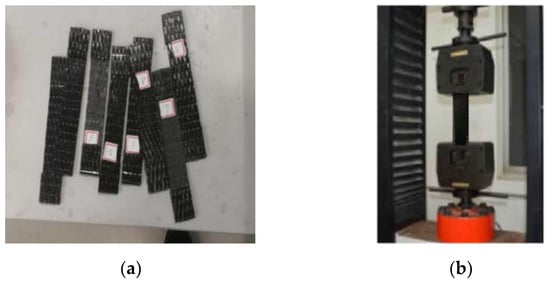
Figure 4.
CFRP specimens and tensile equipment: (a) CFRP specimens; (b) tensile equipment.

Table 1.
Performance parameters of concrete.

Table 2.
Performance parameters of CFRP.
2.2. Experimental Set-Up
A concrete cover plate was placed on top of the beam in the experimental model, and 20 tons of counterweight was uniformly applied onto the concrete cover plate to provide the vertical load. In order to ensure axial pressure loading, a total of four columns were designed for use in the experimental model, and the average experimental value of the concrete strength was used to calculate the axial pressure ratio of the columns, which was 0.25. The base of the experimental model and the reaction floor were fixed with anchor bolts, and the model was loaded by displacement control using an MTS high-precision hydraulic servo actuator. The horizontal displacement and bearing capacity of the experimental model were measured by displacement sensors and force sensors. YHD-100 displacement sensors (Bengbu Dahe Electric Co., Ltd., Bengbu, China) and LK-G500 laser displacement sensors (KEYENCE (China) Co., Ltd., Shanghai, China) were arranged on the beam to jointly check the displacement; it was found that the displacement of the test model featured deviations and twists. The complete test system is shown in Figure 5.
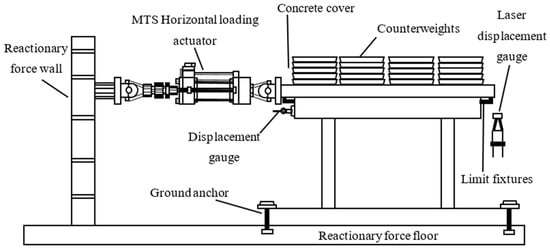
Figure 5.
Experimental loading device diagram.
The test loading conditions were determined according to the building seismic test method regulations JGJ/T 101-2015 []. In order to ensure the continuity and uniformity of repeated loading, a small displacement amplitude is preferred for loading, the step difference should be reduced before yield displacement for loading, and the displacement increment is usually less than 10% of the yield displacement []. In this paper, the initial loading displacement was set as 2.5% of the structure’s yield displacement. The experiment was divided into 14 levels of loading: 0.2 mm, 0.4 mm, 0.8 mm, 1.2 mm, 2.0 mm, 3.0 mm, 4.0 mm, 8.0 mm, 12.0 mm, 16.0 mm, 20.0 mm, 30.0 mm, 40.0 mm and 50.0 mm. Each condition was repeated three times, the loading frequency of 0.2–4.0 mm was 0.05 Hz, and the loading frequency of 8.0–50.0 mm was 0.01 Hz, as shown in Figure 6.
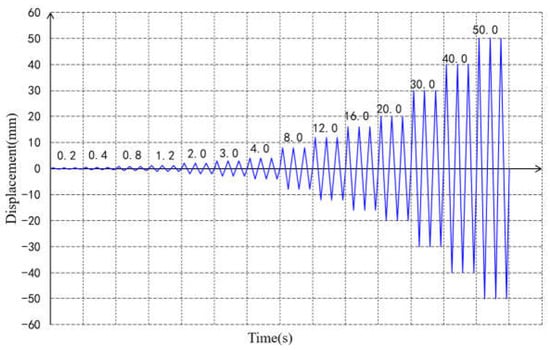
Figure 6.
Experimental loading system diagram.
3. Results and Discussion
3.1. Failure Mode and Experimental Results
When the unreinforced model was loaded to 1.2 mm, the concrete surface was not damaged, and when loading to 2.0 mm, cracks appeared at the ends of the columns first, while the beams were relatively intact, indicating that even if the reinforcing effect of the floor slabs and infill walls were not taken into account, it would be difficult to realize the failure mode of “strong columns and weak beams”. When loaded to 16.0 mm, the crack width increased greatly and extended to the beam–column node; when loaded to 20.0 mm, cracks began to appear on both sides of the beam end; when loaded to 30.0 mm, the cracks at the beam–column node penetrated into the bottom of the beam, part of the concrete was dislodged, and the cracks at the top of the column were obvious. When loaded to 50.0 mm, the concrete at the beam–column node and the bottom of the beam was dislodged, and at this point, the bottom of the column developed large cracks with concrete dislodgement, as shown in Figure 7.
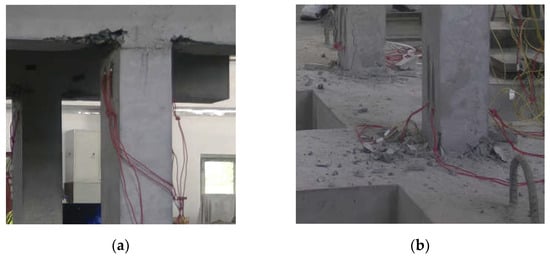
Figure 7.
Column failure under the ordinary model: (a) column top destruction; (b) column bottom damage.
When the CFRP-retrofitted model was loaded to 8.0 mm, the concrete surface was not damaged; when loaded to 12.0 mm, the beam–column node area began to display small cracks, which gradually become larger with the increase in displacement. Under 16.0 mm loading, beam–column node cracks began to develop; under the 20.0 mm condition, the beam end began to experience damage, accompanied by a small amount of concrete dislodgement; with 30.0–50.0 mm three-level loading, damage became obvious in the beam-column node area and beam end, accompanied by a large amount of concrete dislodgement, as shown in Figure 8. Compared with the failure mode of the ordinary model, cracks appeared earlier in the beam–column node area and the beam end of the retrofitted model; the beam end showed a large amount of concrete dislodgement under the 30.0 mm condition, and the damage that developed at the end of the column was significantly smaller than that in the ordinary model, indicating that the strength of the column was significantly improved after CFRP retrofitted, and the failure mode was changed from “column hinge” damage to “beam hinge” damage.
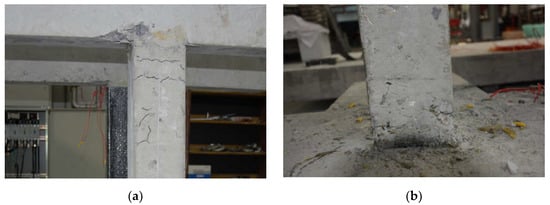
Figure 8.
Column damage under the CFRP retrofitted model: (a) damage to the bottom of the beam; (b) column bottom damage.
The hysteresis curve describes the load–deformation relationship of a structure under reciprocating horizontal loads, reflecting the deformation performance, stiffness degradation and energy dissipation characteristics of the structure. The hysteresis curves of the two groups of models are shown in Figure 9. From the comparison of the hysteresis curves, it can be seen that the peak load-bearing capacity and initial stiffness of the ordinary model are smaller than those of the retrofitted model, and the hysteresis curves show obvious pinching phenomena, which indicate that the beam–column system has an insufficient energy dissipation capacity and that the degradation in the load-bearing capacity is more serious; the load-bearing capacity under the 50.0 mm condition is only 56.92% of the peak load-bearing capacity. The peak load-bearing capacity of the CFRP retrofitted model is significantly improved and the hysteresis curve is relatively fuller, while the load-bearing capacity under the 50.0 mm condition degraded to 80.91% of the peak load-bearing capacity, which is still more satisfactory. The retrofitted beam–column system has a more desirable energy dissipation capacity and ductility.
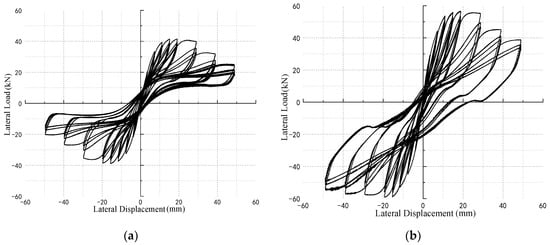
Figure 9.
Hysteric load–displacement responses curve: (a) ordinary model; (b) CFRP-retrofitted model.
The skeleton curve is the envelope curve obtained by connecting the load peak points of each level of loading to the hysteresis curve, which can respond to the maximum value of the horizontal load of each cycle of loading, and is the basis for determining the characteristic features of the restoring force model. According to Table 3 and the skeleton curves (Figure 10) and stiffness degradation curves (Figure 11) of the two groups of models, the load-bearing capacity of the CFRP-retrofitted model is more significantly improved relative to the unreinforced model, and the stiffness is also improved to a certain extent. The peak load-bearing capacity of the retrofitted model was increased by 43.89%, the initial stiffness by 39.27%, and the ductility by 30.1%. The experimental results show that CFRP retrofitting effectively improves the peak load-bearing capacity, ductility, and stiffness of the structure, while optimizing the failure modes and overall performance of the structural system.

Table 3.
Experimental results of the two groups of models.
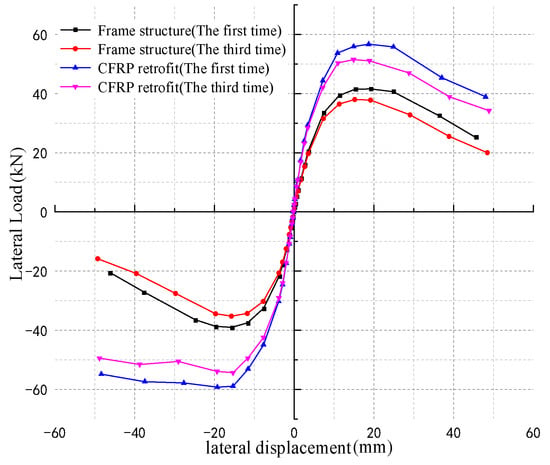
Figure 10.
Load–displacement envelope curves of the two models.
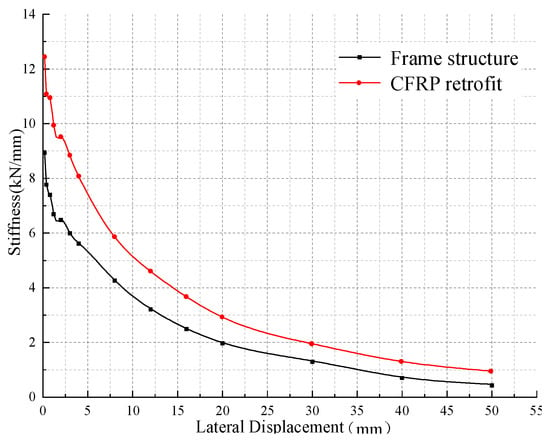
Figure 11.
Stiffness degradation curves of two models.
3.2. Finite Element Modelling and Analysis
In order to better carry out a parametric study of CFRP retrofitting and investigate the effects of the retrofitting method on the seismic performance of a frame structure, a finite element model of a reinforced concrete frame structure has been established in this paper, and the beam–column dimensions, reinforcement, material properties, restraining methods, axial compression ratios, and loading conditions of the finite element model are all consistent with those of the experimental model. For computational efficiency, a one-bay, one-span approach was used for modeling. A C3D8R solid unit was used for concrete, T3D2 truss units for the rebar, and M3D4R shell units for the CFRP [,]. The model was constructed in the ABAQUS 2020 software. The finite element model is shown in Figure 12.
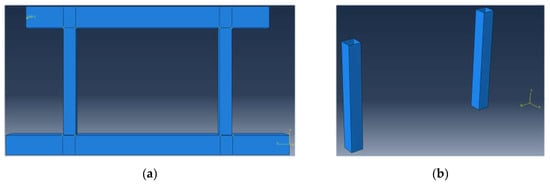
Figure 12.
Finite element model: (a) ordinary model; (b) CFRP model.
The concrete damaged plasticity (CDP) model was used to assess the concrete constitutive relation, the bilinear hysteretic system with degraded stiffness was used to assess the reinforcement constitutive relation, and the orthogonal anisotropic linear elasticity model was used to assess the CFRP; the constitutive relations of the three materials are shown in Figure 13. The parameters of all three materials were obtained via the experiment, and the detailed information is shown in Table 4, Table 5 and Table 6.

Figure 13.
Constitutive relationships of each material: (a) concrete damaged plasticity; (b) bilinear hysteretic system with degrading stiffness; (c) constitutive relationships of CFRP.

Table 4.
Material parameters of concrete.

Table 5.
Material parameters of CFRP.

Table 6.
Material parameters of steel rebar.
3.3. Result of Finite Element Analysis
The failure mode of the two models under the 50.0 mm condition are shown in Figure 14. As can be seen from the damage comparison diagrams, the damage at the top of the CFRP-retrofitted model’s columns obviously extends into the beam, and the damage at the bottom extends into the floor beam. Stress diagrams of the reinforced cage are shown in Figure 15. The damage of the steel cage in the retrofitted model extends into the beam, and the high-stress region of the steel cage in the beam is obviously enlarged, which indicates that the failure mode of the beam–column structure can be optimized and the column damage region can be reduced by CFRP retrofitting. In summary, the failure mode of the frame structure under the action of lateral force is changed from “strong beams and weak columns” plastic hinge brittle failure to “strong columns and weak beams” plastic hinge ductile damage when retrofitted with CFRP.

Figure 14.
Frame model plastic damage: (a) original model; (b) CFRP-retrofitted model.

Figure 15.
Steel cage stress diagram: (a) ordinary model; (b) CFRP-retrofitted model.
The skeleton curves of the two models are shown in Figure 16, and the hysteresis curves of the two models are shown in Figure 17. Due to the slip between the cover plate and the model during the experiments, it is difficult to simulate this phenomenon via numerical model hysteresis curves, so the hysteresis curves do not have a high degree of fit. Comparisons of the skeleton curves show that the peak data of the numerical model and the experimental model at all levels are close to each other, and the trend in both is roughly the same, but the resulting cumulative damage simulation for the model under the condition of large displacement is not ideal (the data in the third circle have a lower degree of fit). In general, the numerical model can simulate the experimental results more accurately. At the same time, it should be noted that the simulated peak load-bearing capacity at the same level is slightly higher than the experimental value.
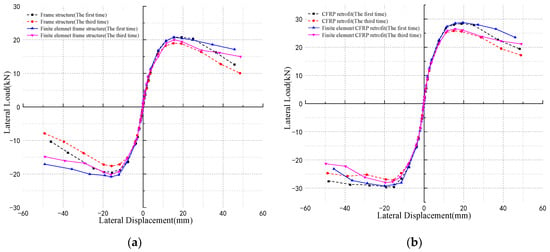
Figure 16.
Load–displacement envelope curves: (a) ordinary model; (b) CFRP-retrofitted model.
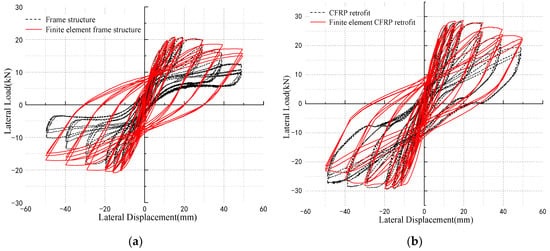
Figure 17.
Hysteric load–displacement response curves: (a) ordinary model; (b) CFRP-retrofitted model.
The ductility coefficients in Table 7 are calculated with the assumption that , where is the ductility coefficient, is the ultimate lateral displacement, taken as the lateral displacement corresponding to the specimen when the ultimate load is reduced to 85%, and is the yield displacement; the latter two are both obtained according to the farthest point method proposed by Feng Peng et al. [,].

Table 7.
Experimental and finite element results.
4. Finite Element of CFRP-Retrofitted Reinforced Concrete Columns
4.1. Finite Element Model Reinforcement Scheme
In order to further investigate the influence of CFRP retrofitting on the seismic performance of reinforced concrete frame structures, based on the model of numerical analysis shown in the previous section, six kinds of CFRP-retrofitted models were designed for the parametric research, with the amount of CFRP, the spacing, and the width of strips as control parameters. The detailed parameters of CFRP retrofitting are shown in Table 8, and the CFRP-retrofit model is shown in Figure 18.

Table 8.
Column model parameters.
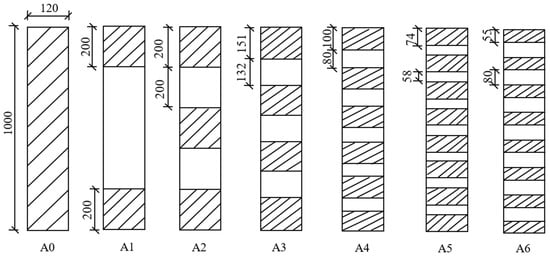
Figure 18.
CFRP retrofit column diagram.
4.2. Results of Finite Elements Modeling
The results of the analysis of the eight models are listed in Table 9, and the skeleton curves are shown in Figure 19. In A1, A2, and A0, the peak loads are 24.46 kN, 25.63 kN, and 29.06 kN, respectively, indicating that the improvement in bearing capacity has an approximately linear relationship with the area covered by CFRP. However, the ductility performance of A1 is the worst among the three models, indicating that only the ends of the columns are strengthened, which reduces the equivalent ratio of the shear span to the effective depth of the columns, and leads to a decrease in the ductility coefficient. Comparing A1 and A6, with the same wrapped area, the number of strips is greater in the latter, while the spacing is smaller, and the bearing capacity and ductility are improved.

Table 9.
Finite element analysis results of different reinforcement models.
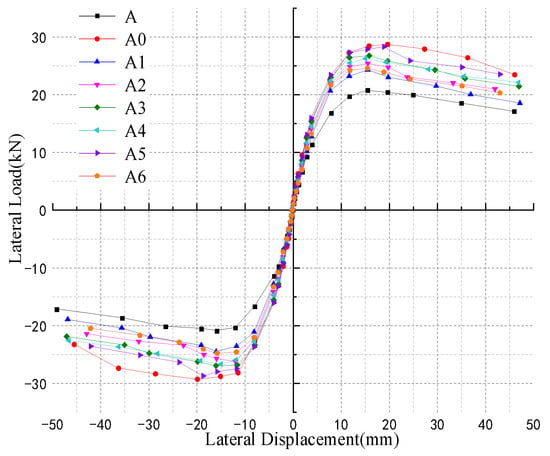
Figure 19.
Load–displacement envelope curves for each group.
According to the skeleton curves of each model (Figure 19), it can be seen that the peak load of the retrofitted model is improved no matter what kind of method is used, and the rate of improvement in the peak load increases with increases in the amount of CFRP; the peak load of the fully wrapped model increases the most. The A1 model is retrofitted only at the ends of the columns; it shows a smaller increase in the peak load and it has the poorest ductility. The influence of the A2~A6 retrofit models varied according to the width and spacing of the CFRP strips. The strip-retrofit model showed a relatively slow rate of decrease in its skeleton curve after reaching the maximum peak load, which was attributed to the fact that, with the increase in the amount of CFRP, the area of corresponding CFRP restraining the concrete became larger, and the restraining effect was also increased.
Table 9 shows that the initial stiffness and ductility of A0 and A2~A6 underwent different degrees of improvement, among which the peak load after the application of the model of full wrapping showed the greatest improvement, reaching 40.42%. Meanwhile, it should be noted that the initial stiffness of A1, which was only retrofitted at the top and bottom ends of the column, increased by 20.56%, but the ductility decreased by 2.57% compared with that of the ordinary model, which was the only way in which ductility was reduced. A4 showed the best deformability, with a 35.97% increase in ductility; here, the width of the strips was 1/10 of the column height, and the strip width to spacing ratio was 1:0.8.
Figure 20 shows the stiffness degradation curves of each model. It can be seen that the initial stiffness values of the retrofitted models underwent different degrees of improvement, and the initial stiffness of the fully wrapped model showed the largest improvement. Meanwhile, the influences of different retrofitting methods on stiffness degradation are not significant, and the stiffness degradation trends of all models are basically the same. The stiffness degradation trends all gradually slowed down when the storey drift ratio exceeded 5%.
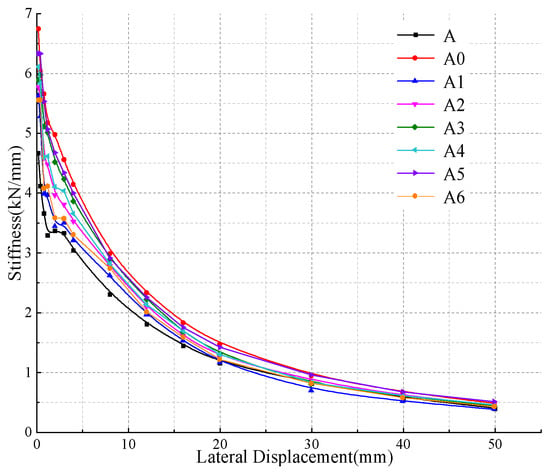
Figure 20.
Stiffness degradation curves of each group.
The influence of the strip width to spacing ratio on the ductility of the retrofitted frame structure is illustrated in Figure 21. The ductility coefficient and peak load increased with the increase in the amount of CFRP between A0, A1 and A2. From the comparisons between A1 and A6, A2, A3, A4 and A5, and A0 and A4, it was found that with a reasonable design of strip width to spacing ratio, the ductility of the strip-retrofitted model will be better than that of the fully wrapped model, and the ductility coefficient increases with the increase in this ratio when the strip to spacing ratio is less than 1.25 for the same region of retrofitted CFRP. The A4 and A5 models illustrate that, when seeking to increase the ductility, the strip width cannot be reduced too much. Based on the investigation results, the recommended ratio of CFRP strip to spacing is 1 to 1.25.
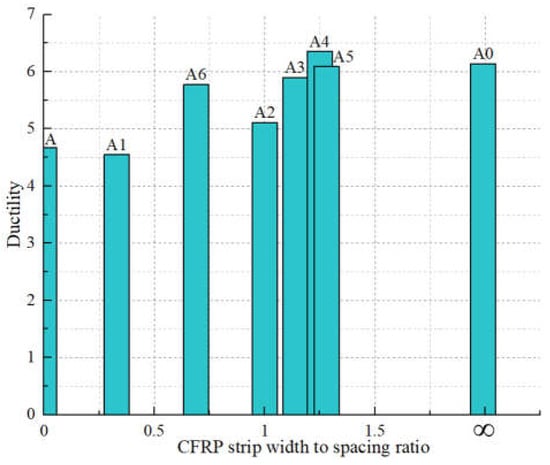
Figure 21.
Diagram of the relationship amongst ductility factors for each group.
5. Conclusions
In this experimental study, the seismic performances of reinforced concrete frame columns retrofitted with CFRP were analyzed via static tests on two sets of two-bay, one-span frame structure models, establishing finite element models on the basis of the experiment results, and carrying out a parametric study of CFRP retrofitting, which assessed the influence of CFRP retrofitting on the failure modes, hysteresis curves, skeleton curves, hysteresis dissipation, and stiffness degradation. The following conclusions were obtained:
- (1)
- Based on the results of the static seismic tests, the peak load, initial stiffness and ductility of the fully wrapped CFRP model were improved by 43.89%, 39.27% and 30.1%, respectively. The beam end of the retrofitted model showed obvious “plastic hinge” damage, while the plastic hinge region of the column was significantly reduced, indicating that CFFP retrofitting improved the overall failure mode while improving the seismic performance of the reinforced concrete frame, causing the failure mode to change from “column hinge” damage to “beam hinge” damage;
- (2)
- Based on the results of numerical analysis, we can see that the horizontal peak load of reinforced concrete frames is approximately linearly related to the region of CFRP retrofitting. In the case when the same region of CFRP is retrofitted, the retrofitting method has a more significant influence on the structural ductility. The A6 model’s ductility coefficient is 5.77, while that of model A1 is only 4.55. The A4 model’s ductility coefficient is 6.35, while that of A3 is only 5.90;
- (3)
- Both fully wrapping and strip-wrapping with CFRP can effectively improve the seismic performance of reinforced concrete frame structures, and when the CFRP width to spacing ratio is between 1.0 and 1.25, the structural system will reach the optimal ductility while guaranteeing the lateral load-bearing capacity.
Author Contributions
Conceptualization, methodology, Y.Z. and X.G.; software, formal analysis, visualization, X.L. and X.Z.; validation, Y.Z.; resources, data curation, X.G.; writing—original draft preparation, X.L.; writing—review and editing, Y.Z., X.L. and X.Z. All authors have read and agreed to the published version of the manuscript.
Funding
This research was funded by the Foundation of Fundamental Research Funds for the Central Universities (ZY20230319) and the Foundation of Seismic technology Spark Project (XH21055).
Data Availability Statement
The raw data supporting the conclusions of this article will be made available by the authors on request.
Conflicts of Interest
The authors declare no conflicts of interest.
References
- Guo, X. Collapse Mechanism of RC Frame Structures Suffered from Strong Earthquake, 1st ed.; China Architecture & Building Press: Beijing, China, 2018. [Google Scholar]
- Zhang, M.Z. Building damage in Dujiangyan during Wenchuan earthquake. Earthq. Eng. Eng. Dyn. 2008, 7, 263–269. [Google Scholar] [CrossRef]
- Guo, X. Characteristics and mechanism analysis of the great Wenchuan earthquake. Earthq. Eng. Eng. Dyn. 2009, 29, 74–87. [Google Scholar]
- Tan, H.; Lu, H.L.; Zhang, G.C. Earthquake damage analysis of Wenchuan earthquake frame structure. World Earthq. Eng. 2016, 32, 91–96. [Google Scholar]
- Ye, L.P.; Qu, Z.; Ma, Q.L.; Lin, X.C.; Lu, X.Z.; Pan, P. The realization of the yield mechanism of “strong column and weak beam” based on the earthquake damage of frame structures in Wenchuan earthquake. Build. Struct. 2008, 11, 52–59. [Google Scholar]
- Xian, G.J.; Guo, R.; Li, C.G.; Wang, Y.J. Mechanical performance evolution and life prediction of prestressed CFRP plate exposed to hygrothermal and freeze-thaw environments. Compos. Struct. 2022, 293, 115719. [Google Scholar] [CrossRef]
- Carra, G.; Carvelli, V. Long-term bending performance and service life prediction of pultruded glass fiber reinforced polymer composites. Compos. Struct. 2015, 127, 308–315. [Google Scholar] [CrossRef]
- Hajihashemi, A.; Mostofinejad, D.; Azhari, M. Investigation of RC beams strengthened with prestressed NSM CFRP laminates. Compos. Constr. 2011, 15, 887–895. [Google Scholar] [CrossRef]
- Seica, M.V.; Packer, J.A. FRP materials for the rehabilitation of tubular steel structures, for underwater applications. Compos. Struct. 2007, 80, 440–450. [Google Scholar] [CrossRef]
- Mohabeddine, A.; Correia, J.; Montenegro, P.A.; De Jesus, A.; Castro, J.M.; Calçada, R.; Berto, F. An approach for predicting fatigue life of CFRP retrofitted metallic structural details. Int. J. Fatigue 2022, 154, 106557. [Google Scholar] [CrossRef]
- Li, C.G.; Xian, G.J. Novel wedge-shaped bond anchorage system for pultruded CFRP plates. Mater. Struct. 2018, 51, 162. [Google Scholar] [CrossRef]
- Lu, Y.Y.; Chen, J.; Huang, Y.S.; Wu, T. New progress in study of the technology of strengthening structures with prestressed fiber reinforced plastics. Eng. Sci. 2008, 8, 40–44. [Google Scholar]
- Zhao, T.; Dai, Z.Q. Experimental study on seismic resistance of reinforced concrete columns strengthened by carbon fiber sheet. Build. Struct. 2000, 7, 31–34. [Google Scholar]
- Xiao, Y.; Wu, H. Compressive behavior of concrete confined by carbon fiber composite jackets. J. Mater. Civ. Eng. 2000, 12, 139–146. [Google Scholar] [CrossRef]
- Zhang, K.; Yue, Q.R.; Ye, L.P.; Zhao, S.H. Experimental study on improving ductility of concrete column reinforced by carbon fiber sheet. Ind. Build. 2000, 30, 16–19. [Google Scholar]
- Xiao, Y.; Martirossyan, A. Seismic performance of high-strength concrete columns. J. Struct. Eng. 1998, 124, 241–251. [Google Scholar] [CrossRef]
- Dirikgil, T. Corrigendum to “Experimental investigation of the contributions of CFRP and externally collar strengthening to the seismic performance of RC columns with different cross-sections”. Structures 2020, 26, 257–258. [Google Scholar] [CrossRef]
- Wang, J.Z.; Wang, S.Y.; Huang, C.K. Research on ductility and earthquake-resistance of high-strength concrete column confined by CFRP. J. Dalian Univ. Technol. 2008, 48, 708–714. [Google Scholar]
- Wei, H.; Wu, Z.M.; Guo, X.; Yi, F.M. Experimental study on partially deteriorated strength concrete columns confined with CFRP. Eng. Struct. 2009, 31, 2495–2505. [Google Scholar] [CrossRef]
- Wei, H.; Wu, Z.M.; Zhang, P. Axial Experiment on CFRP Confined Steel Reinforced Concrete Columns with Partial Deteriorated Strength. J. Reinf. Plast. Compos. 2010, 29, 874–882. [Google Scholar] [CrossRef]
- Ilki, A.; Peker, O.; Karamuk, E.; Demir, C.; Kumbasar, N. FRP Retrofit of Low and Medium Strength Circular and Rectangular Reinforced Concrete Columns. J. Mater. Civ. Eng. 2008, 20, 169–188. [Google Scholar] [CrossRef]
- Benzaid, R.; Mesbah, H.; Chikh, N.E. FRP-confined concrete cylinders: Axial compression experiments and strength model. J. Reinf. Plast. Compos. 2010, 29, 2469–2488. [Google Scholar] [CrossRef]
- Zhu, H.Y.; Su, Y.C.; Zhang, Y.T.; Chen, J. Study on the performance of various anchoring methods for concrete beams reinforced by CFRP. Value Eng. 2023, 42, 155–158. [Google Scholar]
- Wang, T.Y.; Wu, Y.X.; Zhao, S.B.; Zhang, J.W. Experimental study on flexural performance of damaged short beams reinforced by CFRP sheet. Build. Struct. 2023, 53, 80–86. [Google Scholar]
- Shu, L.; Tan, J.K. Bearing capacity analysis of simply supported bidirectional plate reinforced by CFRP under Uniform load. J. Chengdu Univ. Nat. Sci. Ed. 2015, 34, 297–301. [Google Scholar]
- Fang, Z.; Zhao, K. Experimental study on concrete slab reinforced by mixed anchor CFRP. Transp. Sci. Technol. 2023, 3, 99–102. [Google Scholar]
- Zhang, Z.M.; Li, H.L.; Zhang, Y.X. Nonlinear finite element Analysis of axial compression behavior of concrete rectangular short columns confined by CFRP sheet. J. Shanghai Univ. Nat. Sci. Ed. 2013, 19, 203–207. [Google Scholar]
- Lu, X.Z.; Feng, P.; Ye, L.P. Finite element analysis of axial compression behavior of concrete square column restrained by FRP sheet. J. Civ. Eng. 2003, 36, 46–51. [Google Scholar]
- Guo, X.Y.; Cheng, X.Y.; Ba, W.H. Pseudo-static test of reinforced concrete frame columns strengthened by glass fiber reinforced polymer and carbon reinforced polymer. Build. Struct. 2019, 49, 728–733. [Google Scholar]
- Guo, J.M.; Yu, C.Y.; Xie, Y.P.; Zhang, L. Experimental study on seismic performance of single-layer double-span concrete frame reinforced by carbon fiber. Build. Struct. 2019, 49, 618–621. [Google Scholar]
- Eslami, A.; Dalalbashi, A.; Ronagh, H.R. On the effect of plastic hinge relocation in RC buildings using CFRP. Compos. Part B Eng. 2013, 52, 350–361. [Google Scholar] [CrossRef]
- Balsamo, A.; Colombo, A.; Manfredi, G.; Negro, P.; Prata, A. Seismic behavior of a full-scale RC frame repaired using CFRP laminates. Eng. Struct. 2005, 27, 769–780. [Google Scholar] [CrossRef]
- Chen, W.H.; Shou, W.R.; Qiao, Z.H.; Cui, S.S. Seismic performance of non-ductile RC frames strengthened with CFRP. Compos. Struct. 2019, 221, 110870. [Google Scholar] [CrossRef]
- GB 50010-2010; Code for Design of Concrete Structures. Ministry of Housing and Urban-Rural Development of the People’s Republic of China: Beijing, China, 2016.
- GB/T 3354-1999; Test Method for Tensile Properties of Orientation Fiber Reinforced Polymer Matrix Composite Materials. China Fiber Reinforced Plastics Standardization Technical Committee: Beijing, China, 1999.
- JGJ/T 101-2015; Specification for Seismic Test of Buildings. Ministry of Housing and Urban-Rural Development of the People’s Republic of China: Beijing, China, 2015.
- Wang, D.; Zhao, H.Q.; Lu, X.L. Loading system of quasi-static test method for building structure. Sichuan Build. Sci. Res. 2014, 40, 54–59. [Google Scholar]
- Shi, Y.P.; Zhou, Y.R. ABAQUS Finite Element Analysis Example Explanation, 1st ed.; Machine Press: Beijing, China, 2006. [Google Scholar]
- Gao, P. Research on Axial Compression of Reinforced Concrete Columns Strengthened with BFRP and CFRP. Master’s Thesis, Hefei University of Technology, Hefei, China, 2021. [Google Scholar]
- Feng, P.; Cheng, S.; Bai, Y.; Ye, L.P. Mechanical behavior of concrete filled square steel tube with FRP confined concrete core subjected to axial compression. Compos. Struct. 2015, 123, 312–324. [Google Scholar] [CrossRef]
- Feng, P.; Qiang, H.L.; Ye, L.P. Discussion and definition on yield points of materials, members and structures. Eng. Mech. 2017, 34, 36–46. [Google Scholar]
Disclaimer/Publisher’s Note: The statements, opinions and data contained in all publications are solely those of the individual author(s) and contributor(s) and not of MDPI and/or the editor(s). MDPI and/or the editor(s) disclaim responsibility for any injury to people or property resulting from any ideas, methods, instructions or products referred to in the content. |
© 2024 by the authors. Licensee MDPI, Basel, Switzerland. This article is an open access article distributed under the terms and conditions of the Creative Commons Attribution (CC BY) license (https://creativecommons.org/licenses/by/4.0/).